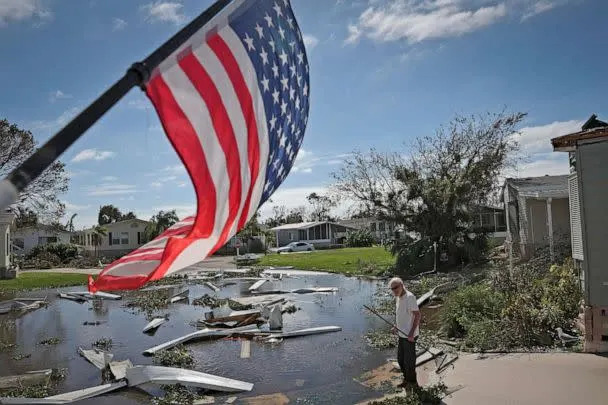ABC News
Hurricane Ian could cripple Florida’s home insurance industry
Alexis Christoforous – September 29, 2022
Hurricane Ian could cripple Florida’s already-fragile homeowners insurance market. Experts say a major storm like Ian could push some of those insurance companies into insolvency, making it harder for people to collect on claims.
Since January 2020, at least a dozen insurance companies in the state have gone out of business, including six this year alone. Nearly 30 others are on the Florida Office of Insurance Regulation’s “Watch List” because of financial instability.
“Hurricane Ian will test the financial preparedness of some insurers to cover losses to their portfolios, in particular smaller Florida carriers with high exposure concentrations in the impacted areas,” Jeff Waters, an analyst at Moody’s Analytics subsidiary RMS and a meteorologist, told ABC News. Waters said Florida is a peak catastrophe zone for reinsurers, and those with exposure will likely incur meaningful losses.

More than 1 million homes on the Florida Gulf Coast are in the storm’s path, and while Ian’s track and severity can change in the coming days, one early estimate pegs the potential reconstruction cost at $258 billion, according to Corelogic, a property analytics firm.
Industry analysts say years of rampant and frivolous litigation and scams have brought Florida’s home-insurance market to its knees, with many large insurers like Allstate and State Farm, reducing their exposure to the state in the past decade.
MORE: What Hurricane Ian means for food and gas prices
“Insurers most exposed to the storm will be the Florida-only insurers, which we define as insurance companies with at least 75% of their homeowners and commercial property premiums written in Florida,” according to a report from Moody’s Analytics submitted to ABC News.
The state-run, taxpayer-subsidized Citizens Property Insurance Corp. stands to lose the most. As more local insurance companies in Florida have closed their doors, Citizens has seen its number of policyholders swell from 700,000 to more than 1 million in just the past year.
Florida state Sen. Jeff Brandes, a Republican from St. Petersburg and a vocal critic of Florida’s insurance industry, warns that if Citizens can’t pay its claims, Floridians should brace for assessments to go up on their own insurance policies under a state law that allows it to assess non-customers to pay out claims.
“Every policy holder in the state of Florida, home and auto, should be watching this storm very carefully because it could have a direct impact on their pocketbooks,” said Brandes. He predicts policy holders will see rate hikes of up to 40% next year as a result of Ian.
A spokesperson for Citizens tells ABC News that if their preliminary estimate of 225,000 claims and $3.8 billion in losses holds, the insurer of last resort would be in a position to pay all claims without having to levy a “hurricane tax” on residents.
Florida is already home to the highest insurance premiums in the U.S., something Charlie Crist, the former Florida governor running against incumbent Gov. Ron DeSantis, blames on his opponent.
“Gov. DeSantis let these insurance companies double Floridians’ rates and they’re still going belly up when homeowners need them most. You pay and pay and pay, and the insurance company isn’t there for you in the end anyway,” Crist said in a statement Monday.
A spokesperson for DeSantis did not immediately respond to ABC News’ request for comment.
In May, DeSantis signed a bipartisan property insurance reform bill into law that poured $2 billion into a reinsurance relief program and $150 million into a grant program for hurricane retrofitting. Among other things, it prohibits insurance companies from denying coverage based on the age of a roof and limits attorney fees on frivolous claims and lawsuits.
At a news conference Tuesday, DeSantis said a lot of the damage from Ian would be from flooding and storm surge. DeSantis said the danger with the Tampa Bay area is that the water has no place to go, noting that the area has close to 1 million residents enrolled in a national flood insurance program.

Homeowner policies typically do not cover flood damage, and most homeowners located in a flood zone often get coverage from the Federal Emergency Management Agency (FEMA). Most private property insurance companies insure primarily for wind damage.
President Joe Biden on Thursday approved DeSantis’ request for a disaster declaration for a number of counties in the state. It includes grants for temporary housing and home repairs and low-cost loans to cover uninsured property losses.
MORE: Biden coordinates with DeSantis and Fla. officials, warns oil companies as Hurricane Ian hits
“The expense will be higher because of higher construction costs and overall inflation,” Denise Rappmund, the vice president of Moody’s Public Project and Infrastructure Finance Group, told ABC News. “FEMA is the key source of aid following a natural disaster, but much of the costs to repair and rebuild damaged property will be borne by property insurers who will benefit from $2 billion of state-funded reinsurance.”
Analysts say Hurricane Ian has the potential to be among the four costliest storms in U.S. history, mostly because Florida’s population has exploded in recent years.
No state in the eastern U.S. has grown faster in population than Florida in the past decade and the state’s fastest growing cities: Tampa, Fort Myers and Sarasota, are all in the storm’s path. Analysts warn that more people and more homes mean that a major storm could become more destructive and costly.
